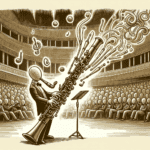The clarinet is more than just an instrument for creating beautiful melodies; it's a versatile tool that lets musicians explore a wide range of sounds and textures. Extended techniques can add depth and complexity to your playing, enhancing your performance whether you're into contemporary classical music, jazz, or experimental styles.
What Are Extended Techniques?
Extended techniques are unconventional ways of producing sound that go beyond standard playing methods. For clarinetists, these can include multiphonics, harmonics, overblowing, flutter-tonguing, and slap-tonguing, among others. These approaches create unique sounds and textures, giving performers new ways to express themselves.
Why Explore Extended Techniques?
- Boosts Creativity: Extended techniques open up new avenues for musical expression and creativity.
- Expands Genre Possibilities: Many contemporary genres use these techniques, making it easier to play different styles.
- Enhances Technical Skills: Working on these techniques can improve your overall proficiency on the instrument.
- Boosts Adaptability: Knowing extended techniques makes you a more flexible player for various performances and ensembles.
Common Extended Techniques for Clarinet
Let's look at some popular extended techniques and how to incorporate them into your playing.
| Technique | Description | Practice Tip |
|---|---|---|
| Multiphonics | Producing multiple pitches simultaneously | Experiment with different fingerings and embouchure adjustments |
| Harmonics | Producing high-pitched overtones | Start with a fundamental note and gradually alter fingerings |
| Flutter-tonguing | Rolling the ‘r' while playing | Practice rolling ‘r's without the clarinet first |
| Slap-tonguing | Creating a percussive sound with the tongue and reed | Focus on quick tongue release on simple notes |
| Overblowing | Producing higher notes with increased air pressure | Start in a comfortable range and gradually increase pressure |
1. Multiphonics
Multiphonics involve producing more than one pitch at the same time. This technique creates rich, layered sounds that work well in contemporary and experimental music. To practice, start by finding the right fingerings and use your embouchure and air support to control the pitch.
Example Multiphonic Fingering
- Left Hand: 1 2 3; Right Hand: 1 2 + Octave Key
- Left Hand: 1; Right Hand: 1 3 (without the octave key)
2. Harmonics
Harmonics are high-pitched overtones produced by playing specific notes with certain fingering combinations. This technique improves tone quality and helps achieve a full sound range.
Practicing Harmonics
- Begin with a fundamental note, such as low C.
- Slowly introduce harmonics by changing fingerings while playing.
3. Flutter-Tonguing
This technique involves rolling the r's while playing to create a rapid, fluttering sound. It adds an interesting texture to your playing, especially in jazz.
How to Flutter-Tongue
- Practice rolling your r's without the clarinet.
- Once you're comfortable, try it while playing a long note.
4. Slap-Tonguing
Slap-tonguing creates a percussive, popping sound by quickly releasing the tongue from the reed. It's common in jazz and can add rhythmic elements to your performance.
Practice Slap-Tonguing
- Start with an easy note and focus on creating a sharp release with your tongue.
- Gradually increase the speed and try to include it in melodic lines.
5. Overblowing
Overblowing is a method used to produce higher notes by applying more air pressure. Learning this technique is key for playing altissimo pitches.
Practicing Overblowing
- Start with a range you're comfortable with and slowly increase pressure.
- Practice reaching the higher register without straining.
Integrating Extended Techniques into Your Practice
As you begin exploring these techniques, it's important to include them in your regular practice routine:
- Daily Warm-ups: Use part of your daily warm-ups to focus specifically on these techniques.
- Take Your Time: Master each technique individually before adding them to your repertoire.
- Record Your Practice: Listen to recordings of yourself to track progress and identify areas for improvement.
Listening Examples
Listening to well-known clarinetists who use these techniques can inspire and guide your practice:
- David Shifrin: Known for his expressive style that incorporates various extended techniques.
- Benny Goodman: While famous for swing, he also explored different tonalities.
- Richard Stoltzman: A contemporary clarinet expert who frequently uses extended techniques in his performances.
Embracing extended techniques on the clarinet allows you to express a wider range of sounds and styles. Practice regularly, experiment, and enjoy expanding your musical abilities!







